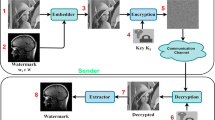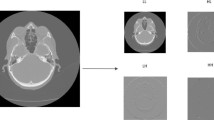Abstract
With the increasing popularity of digital data in the healthcare domain, data hiding has become a hot research topic for covert communication and privacy protection. Existing data-hiding methods often tend to results in increased imperceptibility and robustness, which are also needed to simultaneously improve the system’s security and embedding capacity. To solve this problem, a robust and high-capacity data hiding technique, called HIDEmarks, our study proposed a combination of integer wavelet transform (IWT) and least significant bit (LSB) for healthcare. Specifically, the IWT-LSB was used to embed multiple marks into the medical colour image. The technique first transformed cover images into three channels, and then each channel was transformed using IWT. After this, multiple marks were concealed into the cover media with the help of the LSB scheme. Meanwhile, a lossless soft method was adopted to compress the image mark prior to embedding, thereby reducing storage and transmission overhead and improving the embedding capacity of the marked colour image. Experimental results show that the proposed HIDEmarks achieved superior perceptual quality, robustness and capacity compared with the state-of-the-art schemes.










Similar content being viewed by others
Data availability
In support of this research, no new data were created or examined.
References
Amrit P, Singh AK (2022) Survey on watermarking methods in the artificial intelligence domain and beyond. Comput Commun 188:52–65
Anand A, Singh AK (2020) An improved DWT-SVD domain watermarking for medical information security. Comput Commun 152:72–80
Anand A, Singh AK (2022) A hybrid optimization-based medical data hiding scheme for industrial internet of things security. IEEE Trans Industr Inf 19(1):1051–1058
Begum M, Ferdush J, Uddin MS (2022) A hybrid robust watermarking system based on discrete cosine transform, discrete wavelet transform, and singular value decomposition. J King Saud Univ-Comput Inf Sci 34(8):5856–5867
Cao H, Hu F, Sun Y, Chen S, Su Q (2022) Robust and reversible color image watermarking based on DFT in the spatial domain. Optik 262:1–17
Devi KJ, Singh P, Thakkar HK, Kumar N (2022) Robust and secured watermarking using ja-fi optimization for digital image transmission in social media. Appl Soft Comput 131:1–17
Elhadad A, Ghareeb A, Abbas S (2021) A blind and high-capacity data hiding of DICOM medical images based on fuzzification concepts. Alex Eng J 60(2):2471–2482
Hsieh KS, Wang CM (2022) Constructive image steganography using example-based weighted color transfer. J Inf Secur Appl 65:103126
Kamili A, Hurrah NN, Parah SA, Bhat GM, Muhammad K (2020) DWFCAT: dual watermarking framework for industrial image authentication and tamper localization. IEEE Trans Industr Inf 17(7):5108–5117
Liu XL, Lin CC, Yuan SM (2016) Blind dual watermarking for color images’ authentication and copyright protection. IEEE Trans Circ Syst Vid Technol 28(5):1047–1055
Liu Y, Zhang D, Zhang Q, Han J (2021) Part-object relational visual saliency. IEEE Trans Pattern Anal Mach Intell:1–10
Mehraj S, Mushtaq S, Parah SA, Giri KJ, Sheikh JA, Gandomi AH, Hijji M, Gupta BB, Muhammad K (2022) RBWCI: robust and blind watermarking framework for cultural images. IEEE Trans Consum Electron 69(2):128–139
Moad MS, Kafi MR, Khaldi A (2022) A wavelet based medical image watermarking scheme for secure transmission in telemedicine applications. Microprocess Microsyst 90:104490
Nanashi (2022) Super resolution benchmarks. In: Kaggle. https://www.kaggle.com/datasets/jesucristo/super-resolution-benchmarks. Accessed 8 Jul 2023
Shao Z, Han J, Marnerides D, Debattista K (2022) Region-object relation-aware dense captioning via transformer. IEEE Trans Neural Netw Learn Syst:1–12
Singh OP, Singh AK (2021) A robust information hiding algorithm based on lossless encryption and NSCT-HD-SVD. Mach Vis Appl 32(4):1–13
Singh OP, Singh AK (2022) Image fusion-based watermarking in IWT-SVD domain. In: Advanced machine intelligence and signal processing. Springer, Singapore, 163–175
Singh OP, Singh AK, Srivastava G, Kumar N (2020) Image watermarking using soft computing techniques: a comprehensive survey. Multimed Tools Appl 80:30367–30398
Singh KN, Singh OP, Singh AK, Agrawal AK (2022) Watmif: multimodal medical image fusion-based watermarking for telehealth applications. Cogn Comput:1–17
Singh OP, Singh AK, Agrawal AK, Zhou H (2022) SecDH: security of covid-19 images based on data hiding with PCA. Comput Commun 191:368–377
Sinhal R, Sharma S, Ansari IA, Bajaj V (2022) Multipurpose medical image watermarking for effective security solutions. Multimed Tools Appl 81:14045–14063
Su Q, Yuan Z, Liu D (2018) An approximate Schur decomposition-based spatial domain color image watermarking method. IEEE Access 7:4358–4370
Thomas J (2009) Medical records and issues in negligence. Indian J Urol IJU: J Urol Soc India 25(3):384–388
Tschandl P, Rosendahl C, Kittler H (2018) The HAM10000 dataset, a large collection of multi-source dermatoscopic images of common pigmented skin lesions. Sci Data 5(1):1–9
Vaidya SP (2022) Fingerprint-based robust medical image watermarking in hybrid transform. Vis Comput 39:2245–2260
Wan W, Wang J, Zhang Y, Li J, Yu H, Sun J (2022) A comprehensive survey on robust image watermarking. Neurocomputing 488:226–247
Wang H, Su Q (2022) A color image watermarking method combined QR decomposition and spatial domain. Multimed Tools Appl 81:37895–37916
Wang XY, Wen TT, Shen X, Niu PP, Yang HY (2020) A new watermark decoder in DNST domain using singular values and gaussian-cauchy mixture-based vector HMT. Inf Sci 535:81–106
Wang B, Jiawei S, Wang W, Zhao P (2022) Image copyright protection based on blockchain and zero-watermark. IEEE Trans Netw Sci Eng 9(4):2188–2199
Wu Z, Xuan S, Xie J, Lin C, Lu C (2022) How to ensure the confidentiality of electronic medical records on the cloud: a technical perspective. Comput Biol Med 147:105726
Xia Z, Wang X, Wang C, Wang C, Ma B, Li Q, Wang M, Zhao T (2022) A robust zero-watermarking algorithm for lossless copyright protection of medical images. Appl Intell 52(1):607–621
Xin G, Fan P (2021) A lossless compression method for multi-component medical images based on big data mining. Sci Rep 11(1):1–11
Yang Y, Zou T, Huang G, Zhang W (2021) A high visual quality color image reversible data hiding scheme based on BRG embedding principle and CIEDE2000 assessment metric. IEEE Trans Circ Syst Vid Technol 32(4):1860–1874
Acknowledgements
This work is supported by research project order no. IES212111 - International Exchanges 2021 Round 2, dt. 28 Feb 2022, under Royal Society, UK.
Funding
The authors state that this work has not received any funding.
Author information
Authors and Affiliations
Corresponding authors
Ethics declarations
Conflict of interest
The authors of this manuscript declare no conflicts of interest.
Additional information
Publisher’s note
Springer Nature remains neutral with regard to jurisdictional claims in published maps and institutional affiliations.
Rights and permissions
Springer Nature or its licensor (e.g. a society or other partner) holds exclusive rights to this article under a publishing agreement with the author(s) or other rightsholder(s); author self-archiving of the accepted manuscript version of this article is solely governed by the terms of such publishing agreement and applicable law.
About this article
Cite this article
Singh, O.P., Singh, K.N., Baranwal, N. et al. HIDEmarks: hiding multiple marks for robust medical data sharing using IWT-LSB. Multimed Tools Appl 83, 24919–24937 (2024). https://doi.org/10.1007/s11042-023-16446-y
Received:
Revised:
Accepted:
Published:
Issue Date:
DOI: https://doi.org/10.1007/s11042-023-16446-y




